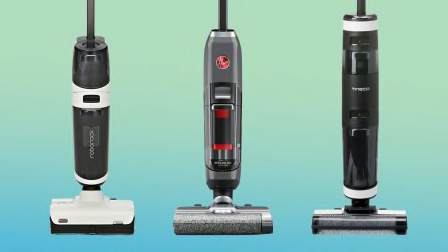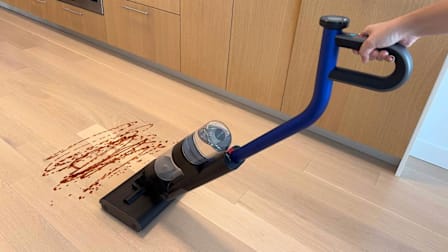5 Things to Know About Combo Vacuum-Mops
They may not be the cleaning panacea that you imagine

The promise of buying an appliance that does it all has always been alluring. Consider the Always Pan, all-in-one washer-dryers, and toaster oven-air fryers. But in Consumer Reports’ tests, we’ve often found that not every multi-tasker does multiple tasks well.
The same can be said for one of the latest entries in our ratings: The combo vacuum-mop. We bought eight of these hybrid cleaners and brought them into our labs and put them through their paces cleaning up spills and stains. And we learned a lot about their advantages and limitations.
So, Can a Combo Vac-Mop Be a Singular Sensation?
Here’s what else to think about if you are tempted to add a vacuum-mop to your collection of cleaning appliances.
They’re Only for Hard Floors
Don’t mistake a combo vacuum-mop with a dedicated carpet cleaner. In fact, they can’t be used on carpet at all because, while they do suck up some of the liquid they dispense, the suction power is not sufficient enough to get all the liquid out of the carpet, leaving it wet. And since they distribute liquid as they work, their vacuuming capability is limited to hard floors like wood, tile, laminate and vinyl. And be careful using one on hardwood, as too much water can damage a wood floor.
They’re Great at Wiping Up Pesky Stains
In addition to cleaning up messes (on hard floors) that a vacuum alone can’t handle, one of the reasons you may want a wet mop is to get rid of stains. You know, all that stuff that falls on the kitchen floor when you’re cooking. To find out how well they remove what you leave behind, we applied spots of three tough stains (hot sauce, espresso with milk, and baby food) to ceramic tiles and allowed them to dry overnight. Overall, the combo vac-mops performed very well. Hot sauce was the toughest stain to erase followed by the baby food (puréed peas). Coffee was the easiest.
They’re Expensive
The combo vacuum mops in our ratings range in price from $180 to $800, but the pricier ones tended to perform better in our tests. For comparison, you can get one of our recommended steam mops like the Bissell PowerFresh 2-in-1 2814 for as little as $65 and a top-notch upright vacuum like the bagged Kenmore Intuition BU4022 or the bagless Shark Navigator Professional NV360 for as low as $150.
Special Cleaning Solutions Cost Extra
While you can use plain water in any of the combo vac-mops in our tests, some also have the option of using a detergent specified by—and available from—the manufacturer for a cost comparable to other common cleaning solutions. For example, the Roborock Dyad Pro Wet and Dry model has a detergent tank that automatically dispenses the soap into the clean water tank during each cleaning session. This handy feature prevents you from wasting detergent, as you might if you are mixing detergent into a tank of water each time you clean, which is necessary with the other combo units.
These Cleaners Are a Mess to Clean
Squeezing out a cloth or sponge mop is no picnic. And most combo vac-mops have self-cleaning cycles—but even those still require you to empty the dirty water tank after wiping the floor, and before you run the self-cleaning cycle. Then, you have to empty the dirty water tank again after running the so-called self-cleaning cycle.
It’s a process and there can be some nasty stuff in there like spilled cereal and milk. You also have to routinely clean the brushroll and the filter for the dirty water tank. And there’s one more yucky chore you shouldn’t ignore: From time to time you should clean out the tube that connects the brushroll to the dirty water tank. Some models come with a cleaning brush for this purpose, but for others you’ll have to improvise or use your fingers to remove the debris.
Keep in mind that you need to let all the parts dry out before putting your machine back together again. And note that some manufacturers recommend replacing the brushroll after six months.
Best Combo Vacuum-Mops
Can a combo vac-mop be a helpful tool in keeping your home clean? See the top picks from our extensive lab tests.


























